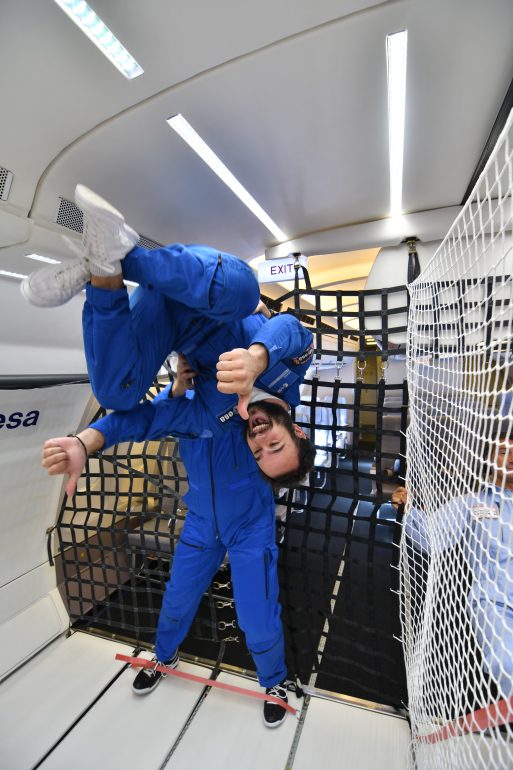Microgravity
“Microgravity is where gravity is (almost) the only force, or where you cannot feel gravity.”
In a spaceship, for example, people don’t feel they are being attracted towards Earth. Of course, any experimental system, e.g. a fluid experimental setup wouldn’t feel that force, if they could feel. However, this does not mean that there is no gravity at all. Many people mistakenly think that gravity does not exist in space. After all, we face a situation in which the Space Station -and what is inside it- are attracted by Earth and nothing else interferes with them. We can express the definition of microgravity in other words:
“Microgravity is where weights do measure only millionths of your weight on Earth.”
This is the origin of the prefix “micro” in microgravity. As a consequence of this, if one astronaut measures his weight in the Space Station, the astronaut and the weight he is on would be flying in the same direction, so the astronaut wouldn’t exert (almost) any force on the weight, measuring only millionths of his weight on Earth.
Microgravity, also called zero-gravity or weightlessness, is the absence of gravity. So that, a micro-g environment is one where the acceleration induced by gravity has little or no measurable effect, gravity itself does not change. It is best illustrated by the following photos in a parabolic flight:
Source: Novaspace
One of the most promising areas for the commercialization of space is in the field of microgravity. Microgravity allows the research and development of new materials which cannot be made on Earth due to gravity. These new materials can be used to speed up future computers, reduce pollution, improve fiber optics, and enable medical breakthroughs to cure diseases.
How to achieve microgravity
Just let it fall!. Indeed, there is no other way. It is not possible, following the physic concepts we know, to thwart the force of gravity and to reproduce the consequences of a microgravity environment without letting fall. The only way to escape from the feeling of gravity is letting it make its work. Here we have some solutions:
-
Drop towers. Drop towers were invented by W. Watts in Bristol in 1775, who first used them to build bullets. They are high towers where researchers can let their experiments fall, obtaining up to ten of seconds of weightlessness. The most capable in Europe is ZARM, located in Bremen. It is 120 metres tall and can get up to 9.3 seconds of weightlessness by means of a catapult which throws the experiment upwards, doubling the free fall longitude.
-
Parabolic flights. They lie in an airplane maneuvering without lift and making up for the drag of air with its engines. This way, the only force acting inside the airplane is the gravity (free fall). The precision of this mechanism is limited, though, reducing the reaction of gravity to a hundredth. European Space Agency (ESA) owns an Airbus 300 equipped to perform such maneuvers, which give up to 25 seconds of weightlessness.
-
Sounding rockets. Without reaching a stable orbit, a rocket launched vertically can achieve during certain time perfect weightlessness conditions. The European MAXUS system, for example, allows experiments which need up to 12 minutes of microgravity environments.
-
Retrievable capsules. These are unmanned, retrievable capsules, derived from the design of the 1960’s Soviet Vostok manned spacecraft and the Zenit military reconnaissance satellite.
-
International Space Station (ISS). In the ISS, experiments can be online for very long periods of time. The mass of the experiment equipment can be very large, only limited by the capacity of the sending procedure. Moreover, the ISS is always manned by operators (yes, astronauts!) who can handle the experiments.
Microgravity consequences
-
Fluids do not receive reaction from the recipient it is in. That is, liquids can be still without touching other things and without recipients pulling them up. Therefore, fluids are under the effects of less forces and can be studied in different conditions.
- Density differences do not create fluid flow. On Earth, denser fluids go under lighter ones (buoyancy). In microgravity there is no leaning making fluids o gases to order in such a way. This means that in such conditions fluids and gases are stiller in the presence of density and temperature differences. If the objetive of a research needs the fluid to remain still for a long time period under controlled temperature circumstances, a micro-g environment is perfect.
-
Support structures unload. Many things on Earth have internal or external structures that support everything not to let it fall. For example, human bodies have hard bones to let other parts of the body lean on them. In microgravity, bones do not support the weight of anything.
-
Hanging Mass based mechanisms work in a different way. All the mechanisms based on pendulum do not work in the same way. A pendulum clock would not work in space, and there are many other mechanisms that would not work either.
Source: NASA





